Shafiqah Samarasam
Malaysia
 |
| Skyline in Kuala Lumpur with haze. 2004. Photo by Nesnad. Via Wikimedia. CC BY 3.0. |
Southeast Asia has experienced detrimental, large-scale air pollution for decades. Known as the “Southeast Asia haze,” this transboundary pollution is largely caused by illegal agricultural fires in the forests of Indonesia. The lingering smoke results in breathing difficulties and adverse health outcomes for the citizens of the region.1
With haze becoming a prevalent, annual issue in neighboring Malaysia, it has also become a practice for Malaysians to wear an N95 mask during haze season. This mask is a form of personal protective equipment that protects wearers from dangerous airborne particles. The history behind its design spans more than 100 years and began with the creativity, grit, and pioneering mindset of Malaysian physician Wu Lien-Teh.
Wu Lien-Teh was born in 1879 in Penang, one of the three Straits Settlements. Wu was a promising student, having won the Queen’s Scholarship and admission to Emmanuel College, Cambridge. He was the first student of Chinese descent at the University of Cambridge. Wu was an incredibly accomplished student and returned to Malaysia to pursue a career in healthcare. Despite being a bright, young physician, laws in the early 1900s favored British nationals over Asians for medical posts. Wu, however, was determined to make his mark and in 1908, he accepted an offer to become the Vice Director of the Imperial Army Medical College in Tianjin, China.2
Two years later, Wu was summoned to investigate the spread of an unknown disease in the northeastern region of China. The epidemic would kill over 66,000 people and become known as the Manchurian plague. In an effort to curb the spread of disease, which was identified as being airborne, Wu pioneered the design of the modern N95 mask by adding more protective layers to existing surgical masks. Wu also implemented additional safety measures such as the wearing of personal protective equipment, quarantine of affected individuals, and sanitation of high-risk areas. Under Wu’s oversight, the plague was eradicated.
Dr. Wu went on to become a prolific member of the international healthcare scene, chairing conferences to discuss the Manchurian plague and the efforts and systems that were put in place to fight it. His contributions earned him a nomination for the Nobel Prize in Physiology or Medicine in 1935, becoming the first Malayan to achieve this honor.3
The Manchurian plague spurred the development of new inventions, ideas, and practices. Though other mask designs existed, it is widely believed that Dr. Wu Lien-Teh’s invention was the forerunner of the modern N95 respirator,4 an essential piece of protective equipment for Malaysians today to protect against both infection and environmental pollution.
References:
- Jenkins N. The 2015 Asian Haze Could Be Among the Worst Ever. Time. https://time.com/4060786/haze-singapore-indonesia-malaysia-pollution/. Published 2021. Accessed September 13, 2021.
- Biography | The Dr. Wu Lien-Teh Society, Penang 槟城伍连徳学会. Wulientehsociety.org. http://wulientehsociety.org/2012/12/11/biography/. Published 2021. Accessed September 13, 2021.
- NobelPrize.org. https://www.nobelprize.org/nomination/archive/show.php?id=11153. Published 2021. Accessed September 13, 2021.
- Zhang P. “Wear a mask. Save lives”: Google honours Chinese face-covering pioneer. South China Morning Post. https://www.scmp.com/news/people-culture/article/3124972/coronavirus-google-honours-chinese-malaysian-doctor-wu-lien-teh. Published 2021. Accessed September 13, 2021.
SHAFIQAH SAMARASAM is a 24-year-old media professional, in love with the written word.
Fall 2021 | Sections | Infectious Diseases

Leave a Reply